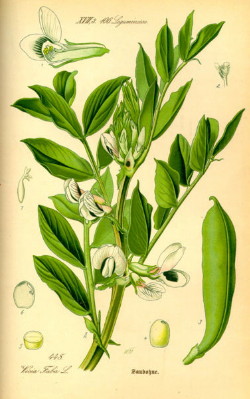Broad Beans
28/06/2013 09:58Broad beans (Vicia faba) are one of the most ancient cultivated crops, with records going back to before 6000 BC. Broad beans, which are also known as ~ Fava Bean, Field Bean, English Bean and Windsor bean, can be eaten fresh or dried.
Broad beans are one of the easiest of legumes to grow and may be sown in autumn or spring. Thrifty wartime gardeners used to cut broad bean stalks back to 10-15cm after harvesting. Shoots from the base of the stalks would develop to form busy stems and produce a smaller crop of beans. A bonus!
Broad beans can look great grown among the flowers in borders and beds. They produce beautiful clusters of white and black flowers. The broad bean flowers are edible, they have a mild bean taste and are very decorative.
You can harvest broad beans for their immature pods. These are delicious cooked whole and served with a white sauce. Simply wash and 'top & tail' before cooking. You can also leave the beans until they begin to show through the pods. If you squeeze the pod gently you will be able to feel how big the beans are. Remove the pods from the plant by pulling downwards and twisting slightly. Be careful not to damage or bend the stem. It’s important to keep picking beans as this will encourage more – stop picking and the plant will stop producing.
If you can’t manage to eat all those broad beans then you can blanch and freeze them. Broad beans are one of the most successful vegetables for freezing. Blanching involves placing the washed and prepared beans into boiling water for 3 minutes then plunging into cold water. Blanching prevents enzymes building up when defrosting and helps to retain the texture and flavour.
In the kitchen broad beans are very versatile and can be used in risotto, stews and salads or mashed up to make a delicious hummus-like dip or just simply serve the beans with a sprinkling of fresh herbs such as parsley, chives, dill or thyme. Here in England we usually use them fresh, but they can also be dried and then used as pulses which are lovely for winter stews. Broad beans can be fried, causing the skin to split open, and then salted or spiced to produce a savoury crunchy snack. These are quite popular in China, Colombia, Peru, Mexico and in Thailand where their name means 'open-mouth nut'.
To remove beans from the pod, snap off one end of the pod and split it open to reveal the broad beans. If beans are still quite small and young, they can be cooked as they are at this stage. If beans are larger, they will benefit from being 'double-podded', this means taking the podded beans, cooking them briefly in boiling water and refreshing under cold water, then just slip off the grey skins to reveal bright-green beans beneath. It isn’t difficult, but it is time consuming and a little fiddly, certainly worth it though - it’s like eating emeralds! These bright-green beans simply need to be cooked lightly until tender and warm.

‘The bean of history’
In ancient Greece and Rome, beans were used in voting - a white bean being used to cast a 'yes' vote, and a black bean for 'no.'
In Italy, broad beans are traditionally sown on November 2, All Souls Day. Small cakes made in the shape of broad beans are known as fave dei morti or 'beans of the dead.'
According to tradition, Sicily once experienced a failure of all crops other than the beans, the beans kept the population from starvation, and thanks were given to Saint Joseph. Broad beans subsequently became traditional on Saint Joseph's Day altars in many Italian communities.
Some people carry a broad bean for good luck, some believe that if one carries a broad bean, one will never be without the essentials of life.
In Portugal, a Christmas Cake called Bolo Rei is baked with a Broad bean inside.
European folklore also claims that planting beans on Good Friday or during the night brings good luck.
BROAD BEAN & MINT PASTA SALAD
Serves 4
450g broad beans
275g pasta shapes
4 tbsp olive oil
2 cloves garlic, chopped
1/2 lemon
small bunch fresh mint, chopped
75g parmesan cheese
Put the broad beans into a pan of boiling water for 4 minutes. Drain and refresh in cold water. Double pod the beans - Slip the beans out of their outer skins to reveal their bright green, tender insides, and set aside. Cook the pasta in boiling water until al dente and drain, reserving a little of the cooking liquid.
Heat the olive oil in a large pan, add the garlic and fry over a gentle heat for about 30 seconds. Add the beans, zest and juice of lemon and season, stirring over heat for a minute. Add the cooked pasta to the pan with a dash of the cooking liquid and stir through the mint. To Serve, pile into bowls and garnish with parmesan shavings.
BROAD BEAN DIP
Serves 4-6
700g fresh broad beans
1 tsp ground cumin
1 tsp paprika
Pinch of chilli powder
1 clove garlic, peeled & chopped
sea salt & black pepper
juice of 1 lemon
7 tbsp extra virgin olive oil
Cook the beans in boiling water for 8 minutes. Puree them in a food processor with the cumin, paprika, chilli powder, garlic and seasoning, then trickle in the olive oil and the lemon juice. Pass through a sieve into a bowl. Serve with warmed pitta breads, sliced for dunking. Or spoon it over the top of white fish fillets as a delicious sauce.